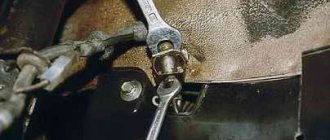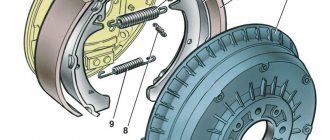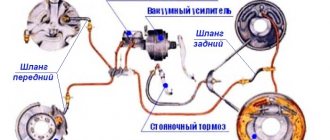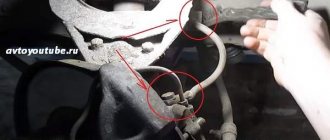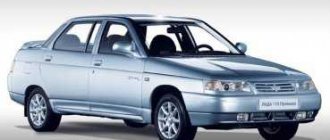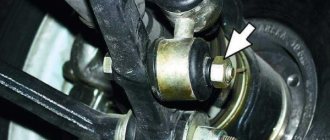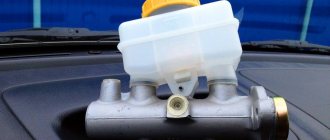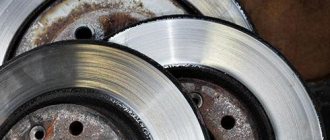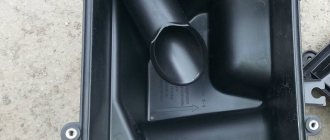Reasons for replacement
Brake hoses are designed to carry brake fluid from the master cylinder, through the brake lines, to the brake wheel cylinders under high pressure and temperature. They work constantly in moving suspension elements, therefore they are made elastic from a rubber compound.
VAZ 2110 brake system diagram
The main reasons for replacing brake hoses on a VAZ 2110 car are:
- the presence of cracks on the outer part during bending;
- abrasions on suspension elements;
- brake fluid leaking from the splined joints of the tube;
- in more rare cases, a defect may occur as a result of a foreign body entering while driving on the road (crushed stone, stones, snow, ice, etc.);
- Also, in exceptional cases, the inner part of the hose peels off (it is not possible to detect it visually), in this case a blockage occurs inside and liquid does not pass through it; it is revealed during dismantling.
This material will help you understand the brake system:
More about materials
Today, brake hoses are divided into two types: rubber, reinforced. Let's look at them in detail:
- Rubber hoses . They have already been briefly discussed above. The hoses are three-layer: two layers of rubber (external and internal) and a reinforcing layer (intermediate). Brake systems with such hoses work slower than engineers expected, since even the most reliable rubber hoses were subject to deformation from high pressure;
- Reinforced hoses . They already have two layers: a tube made of high-strength plastic (polytetrafluoroethylene) or modified rubber and a layer of metal mesh-braid. This two-layer “pie” does not deform, making the hose more reliable. The disadvantage is that the reinforcement can scratch brake system components adjacent to the hose. Manufacturers often make three-layer hoses, with PVC being the third layer.
Practice shows that ordinary rubber has average resistance to a chemically aggressive environment, which is brake fluid. The plastic of reinforced hoses has greater resistance to this fluid, as a result of which many experts consider it the best material for the inner layer of a brake hose. In addition, plastic is thermally stable - its operating temperatures range from -70 to +270°C.
Required replacement parts
To replace the tube on a VAZ 2110, you need a new hose with a copper ring - gasket, a jack, a wheel wrench, a 15 wrench, a 10 wrench (if it is difficult to unscrew the 10 fitting, you need a 10 pentagonal wrench). To bleed the brake system, you will need a 8mm wrench, a thin rubber hose 15–20 centimeters long and a transparent bottle with a capacity of 0.5 liters.
Reinforced brake hoses VAZ 2110
How to change a brake hose
As a rule, the brake system of any car must be in working order at all times. To prevent cracking and breaking of rubber brake hoses, it is necessary to periodically lubricate them with silicone grease.
To carry out repairs, it is recommended to buy or acquire:
a size 8 or 10 wrench, which is used to remove brake pipes; wheel wrench; wrench size 17 and 14; transparent vinyl tube; sealing copper washers; well-penetrating lubricant; a container for draining the “old” brake fluid; new fluid, it is recommended to pay attention to the DOT-4 class.
VAZ 2109 brake pipes
- Preparatory actions are being carried out. The machine is installed on a level place, stops are placed under the wheels on the opposite side in relation to the suspended wheel.
- The front area of the machine (right or left) is raised using a jack. To prevent the car from being supported by only one jack, for safety reasons it is placed on blocks. The wheel can be easily removed using a wheel wrench.
- All replaceable threaded and fixing parts of the system are treated with a well-penetrating lubricant, which ensures easy unscrewing. It is advisable to use the lubricant in advance so that it has time to penetrate deeper into the joints.
Replacement and installation
We put the car on a jack or lift, remove the wheel, for ease of access we unscrew the wheel in the opposite direction from the side of the hose being replaced. Use a 15mm wrench to hold the edge of the inner part of the hoses and use a 10mm wrench to unscrew the fitting. We put a rubber cap on the tip of the tube, removed from the bleeder fitting on the working brake cylinder on the wheel, no matter how much brake fluid flows. We take out the hose from the bracket on the shock absorber and use a 15 wrench to unscrew the fitting from the working brake cylinder. If the copper ring remains on the cylinder, remove it and thoroughly clean the area of dust and dirt before installation. If you don’t have a new copper ring, you can put in an old one, pre-treat it with sandpaper and level the surface. Installation is carried out in reverse order. It is important that after installation the new hose should not be twisted and when turning the wheel in any direction it should not touch the vehicle’s suspension elements.
Replacing brake hoses on a VAZ 2114
The replacement process should begin with preparing the tool and purchasing new spare parts. When purchasing, make sure that the rubber and connecting elements are intact. The design also includes copper rings to seal the connection. The step-by-step replacement procedure for new ones looks like this:
- Before starting work, place the tool within arm's length. Also securely secure the vehicle in one position.
- Remove the wheel and unscrew the ends from the cylinder and body sides. Be careful not to lose the copper O-ring when removing.
- After removing the rubber element, evaluate the condition of other elements of the system, and then proceed to install the new part.
- Check the new element for damage and screw it into place. Don't forget to place the handset in the seat.
Once you have finished installing the new part, you should bleed the brakes. This procedure cannot be carried out without an assistant, because... at the time of pumping, you need to simultaneously press the brake pedal in the cabin. To carry out this work, there is a special fitting on the caliper. The tube placed on it is lowered into a bottle of liquid. Then, by pressing the brake pedal, the fluid is pumped until the air comes out. At the end of the procedure, liquid is added to the tank.
The frequency of replacing hoses depends on the operating conditions of the vehicle. If the hose is installed incorrectly or is kinked, there is a risk of repeated damage. The strength of factory hoses is high, but friction and accidental cuts can still damage the element. Understanding which brake hose is best to install will allow you to choose an option that is suitable in terms of quality and price.
Bleeding the brake circuit
Now it’s time to bleed the brake system of the VAZ 2110. If you only changed one hose, then you can bleed only one side on which you changed it. Add brake fluid to the level in the reservoir under the hood. We unscrew the fitting 8 on the working brake cylinder, on the wheel half a turn and put on the hose. We lower the second part of the hose into a bottle that should contain some brake fluid, the other end of the hose should be immersed in the liquid. To bleed, an assistant is needed; he sits in the driver's seat and presses the brake pedal several times until liquid comes out of the tube lowered into the brake fluid without air bubbles. When the fluid flows, you need to leave the brake pedal pressed, then tighten the fitting to 8. Release the pedal, clean the bleeding areas and connections from brake fluid and dirt, and press the brake pedal forcefully several times and check for brake fluid leaks.
An article dedicated to bleeding brakes on a VAZ 2110 is located here:
Excursion into history
In the first half of the last century, engineers experimented with braking systems. For example, drum brakes appeared, which for some time replaced the still imperfect disc brakes almost completely. But the problem that could not be solved for a long time was the drive problem. Initially, the main brake drive was mechanical. It included cables that stretched from the pedal to various mechanisms and only then to the wheels. Of course, such a braking system was not only not very practical (it required a lot of effort when pressing the pedal, for example), but also suffered greatly from pollution and the effects of chemically aggressive driving. In addition, the cables rusted and deformed under the influence of time and temperature changes. Malcolm Lockheed managed to solve the problem of a mechanical cable drive.
The first hydraulic brake, which had a fairly complex hose system by the standards of the last century, was installed on a Duesenberg back in 1921. ]Chrysler[/anchor] already finalized the system, and then Ford achieved success in this field together with General Motors.
Choosing the right hose
Spare parts for Mazda 2
Summer tires
1.5 P5Y8
Spare parts for Audi 100
Windshield washer fluid 1.6 YM
Finding a suitable hose is not so difficult, and online stores are especially helpful. The fact is that searches can be carried out both by the hose code and by the VIN code. Most likely, the car enthusiast has lost the code for the old “artery” of the brake system, but he can always search by VIN code. Online stores further simplify the search, as they make it possible to select a brake hose based on vehicle parameters : make, year of manufacture and model. It’s worth noting right away that you need to take exactly the hose that is compatible with your car, additionally making sure that it has the same thread parameters as the old one. Pay attention to which wheel the hose being sold is intended for.
Particular attention should be paid to the manufacturer who produces the brake hose suitable for your car. Here is a list of the most famous manufacturing companies:
- Bosch (Germany);
- StopTech (USA);
- Starline (Czech Republic);
- TRW (Germany);
- Fenox (Belarus);
- ATE (Germany);
- Techna Fit (USA).
Starline and Fenox offer mainly inexpensive hoses that are not as good as the original ones, but are very affordable. In the case of Bosch, Fenox and TRW products, you should be wary of counterfeits and check both the product and its packaging with special care. As for American manufacturers, they can boast of excellent quality, but not the widest range of hoses. For example, they produce hoses for Japanese supercars, but have practically no positions for some city car models that are especially popular in Eastern European countries.
